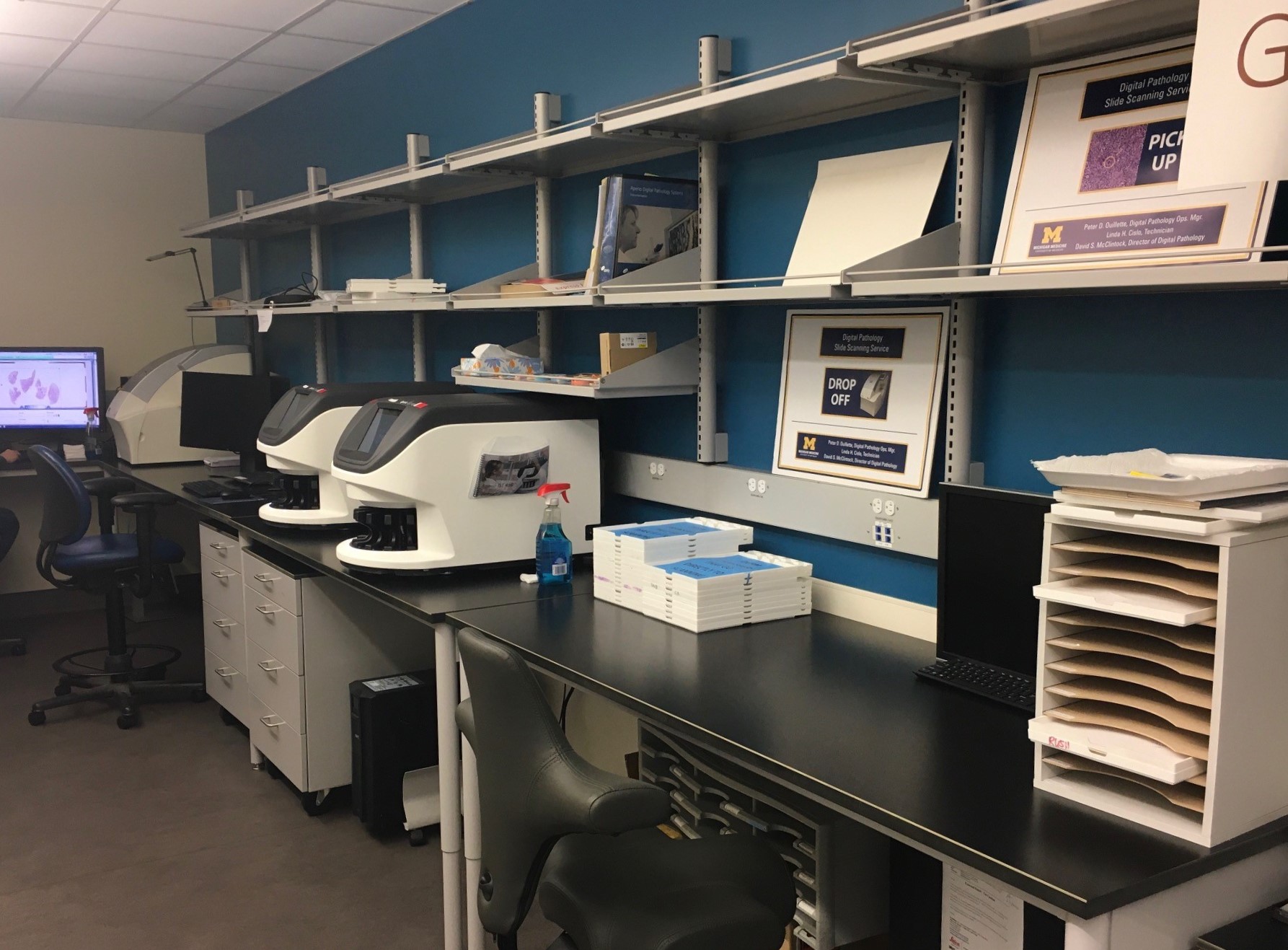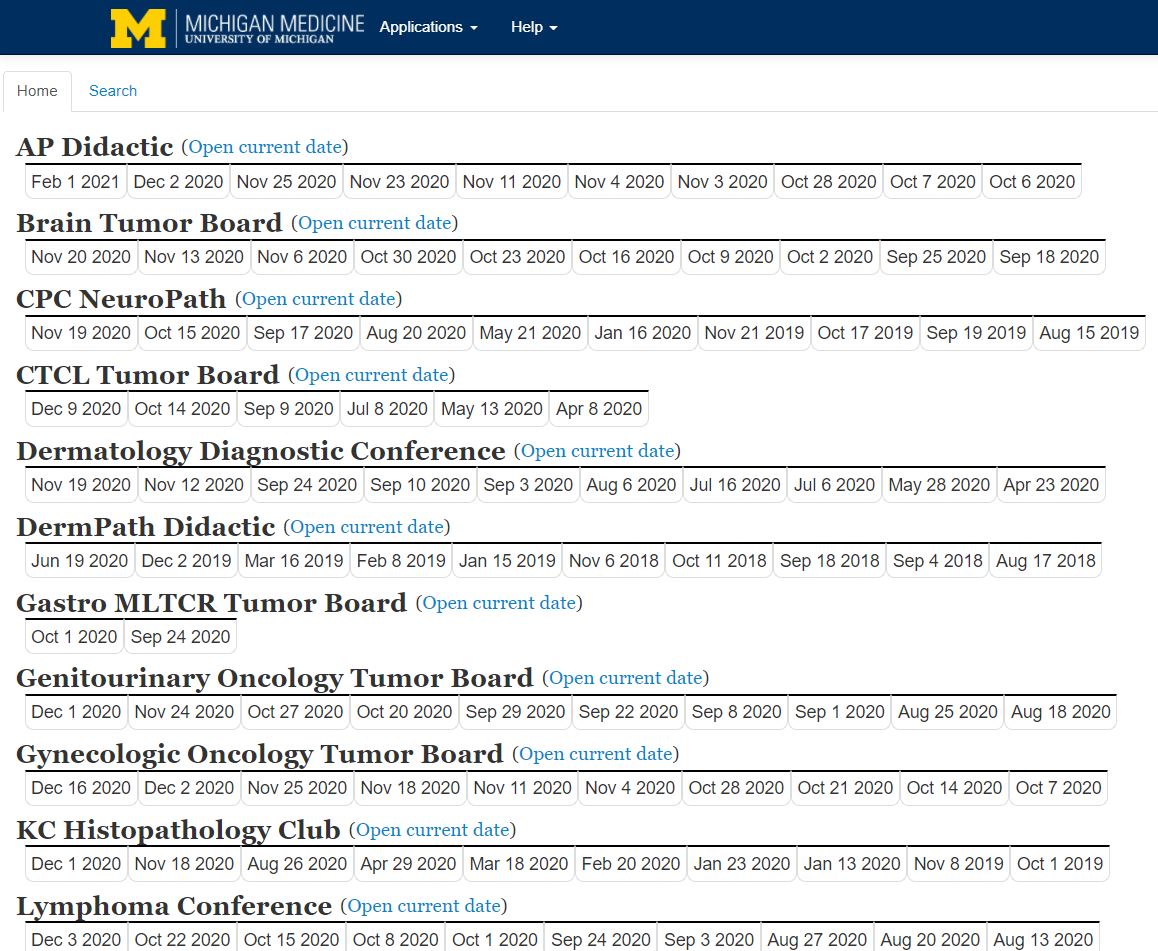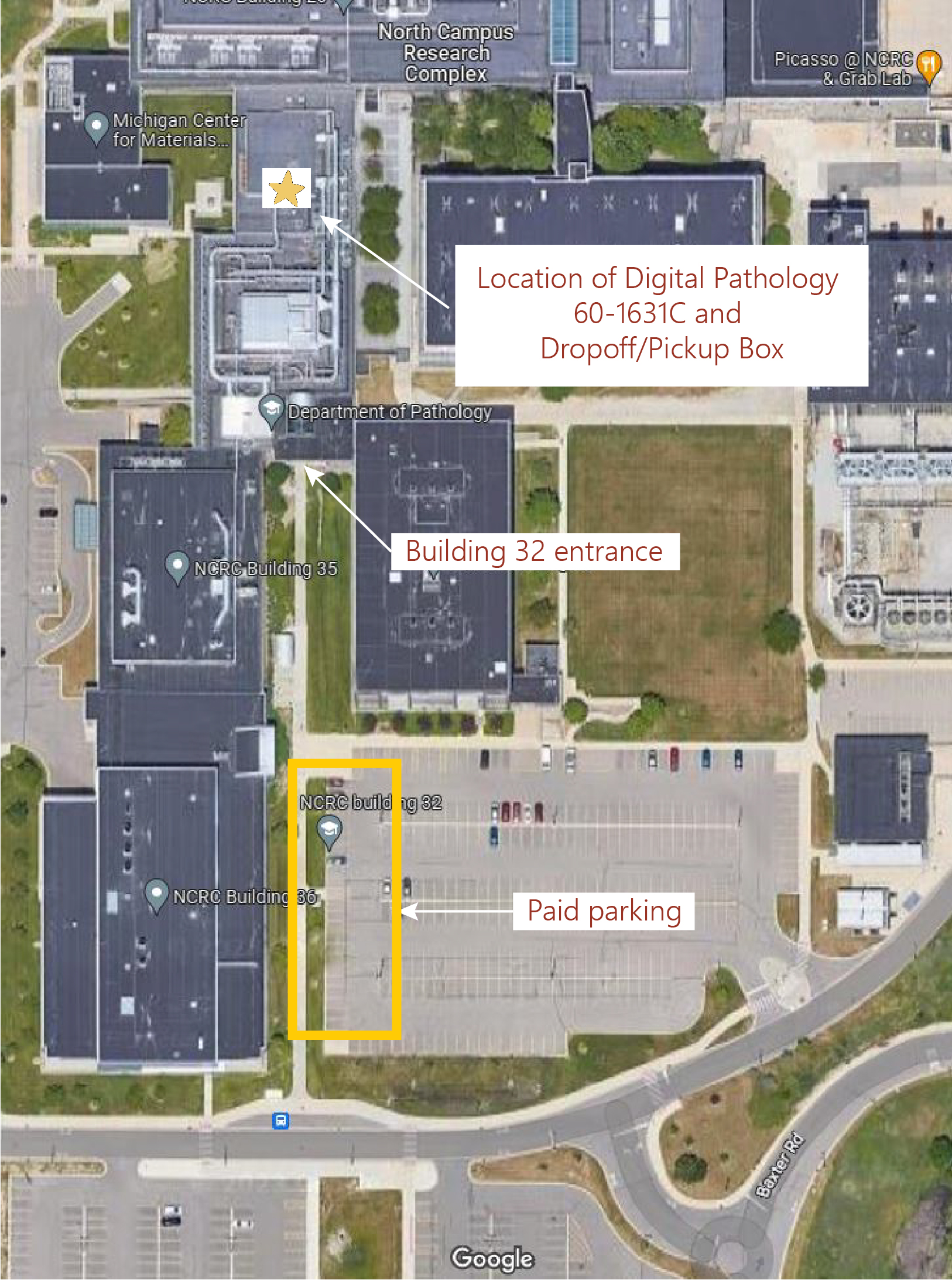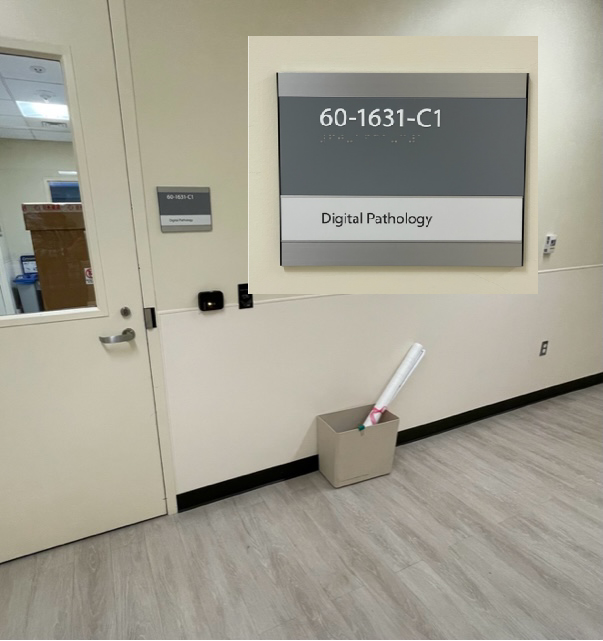Frequently Asked Questions & Tutorials
Q: How do I begin?
Steps:
- Know how to get the glass slides to us.
- Unless prior arrangements have been made, we require a filled-out scan request form prior to the glass slide drop-off.
- Using the form, through the drop-down menus and the "comment" field at the bottom, communicate your intended purpose for the digital images and any additional needs to us. Examples include:
- Faculty member personal collection
- Tumor Board
- Whether copies should be publicly available for educational or collaborative purposes, and if so, via which interface (if you're not sure, we are happy to help).
- Whether you wish copies of the digital slides to be provided to you via secure cloud-based file transfer.
- Know where to look for the digital images once the scanning request is complete.
Next Steps:
 Review the instructions for submitting slides, followed by filling out the online slide submission form & obtaining a printout.
Review the instructions for submitting slides, followed by filling out the online slide submission form & obtaining a printout.- Note for researchers: if you are mounting slides personally, please make sure slides are clean and free of air bubbles trapped beneath the coverslip. Slides must be granted proper conditions for the mounting medium to completely cure: at least 10-18 hours in a well-ventilated space (not inside a small, sealed slide box). Slides suspected of incomplete curing will be held or returned. Avoid excess mounting medium and align the coverslip carefully.
- For requests originating at the NCRC: bring glass slides and the requested printout to NCRC Building 35, G432, area "G". This is located within the Anatomic Pathology cutting area. See photograph. Slides may be picked up from this location following notification of order completion.
- For requests originating at the main medical campus:
- Bring this form and your slides to the location designated in the Transport of Slides to/from NCRC link.
- Slides will be packaged for courier shipment to NCRC. When the slide scan order is finished, slides will be returned to UH via courier. Please allow 3-4 hours after receiving an email notification before checking the designated pickup area in UH for your slides.
Q: How do I see my scanned slide?
First, consider:
- Where do I look for my scanned slide images?
The interface you will use for viewing slides partially depends upon what you communicate to us through the slide scan request form. Michigan Medicine Pathology faculty, House Officers, and staff should consider the search engine within the "Tumor Boards" application inside the Pathology Clinical Lab Portal as their "go-to" interface for viewing scanned slides. This, of course, does not preclude the use of other viewing interfaces. However, the CLP search engine's ease of use and other features recommend it as the principal resource for digital slide viewing.
- Can you put all my slides together in a single folder?
The short answer to this question is "yes." However, it is important to have an understanding of how the folder exists on the server, how its content is accessed, and what it will look like from the end user's experience.
Because Slide Scanning staff can access digital slide content with a direct connection to the server, which end users cannot, we see folders just as you would see them in a standard Windows File Explorer interface. When instructed to create specific folders for specific purposes, we do so. Absent specific instructions, we follow past practices based on the use case indicated to us through the slide scan request form.
The end user accesses digital slide images using one of our interfaces below. The most commonly used interface is the search engine on the Clinical Lab Portal. The CLP search engine lacks the ability to return groups of images organized by folder, however. Our vendor-created database, eSlide Manager, allows a user to return groups of slides organized by folder, but there is a learning curve associated with it. We are happy to teach interested individuals how to make use of the advanced search techniques in eSlide Manager. In the case of the public-facing "IM2," folder icons are visible, discrete, and easily understandable. However, IM2 operates within a set of constraints, as described below.
Available Interfaces for Viewing Slides
- The search engine within the Pathology Clinical Lab Portal
- Searches the entirety of our scanned slide collection
- Can open scanned slides directly using either ImageScope or WebScope
- Copy of Path Lab report provided if available
- Behind U-M firewall; access is limited to those Pathology faculty and staff with permission to access the "Tumor Boards" application within the Portal.
- If a slide has been archived, it will be documented on the interface. If a copy of the image is on the Virtual Slide Box (a server separate from our main one), a link will be provided.
- eSlide Manager
- Vendor-provided whole-slide image database and image management solution
- Pros: can execute more sophisticated (Boolean, combinatorial) searches within our available scanned slides. May provide more metadata for a given slide or slide set vs the Clinical Lab Portal search engine.
- Cons: less user-friendly vs the Clinical Lab Portal search engine; requires more training to learn how to use it. Will not return results from the entirety of our scanned slide library
- Is behind the UM firewall; access is limited to those faculty and staff with an account.
- If a slide has been archived, the image cannot be opened, and no thumbnail will be visible. No link to the VSB is provided if a copy of the image is located there.
- More information on Getting Started.
- The Pathology Virtual Slide Box
- Information and images are publicly available; different server resources than the one housing our principal digital slide library.
- Intended only for slides with educational purpose
- Because slides here are publicly accessible, content on the VSB consists of image copies that have been de-identified. A copy of the digital slide with the captured slide label image and any identifying information on it is maintained on our server behind the UM firewall.
- Indicate your interest in having de-identified slide copies pushed to the VSB by making use of the "radio button" on the slide scan request form. In addition, please notify us in the comments which collection you wish them to be included in.
- NOTE: as of November 2020, the VSB features an option for users of opening slides with a local copy of "ImageScope" software or by using "WebScope" to open images within their browser. However, this particular "WebScope" instance is Flash-based, and Flash will be permanently blocked on web browsers after December 31, 2020. Pathology Informatics is working on solutions. Thank you for your patience.
- IM2
- Information and images are publicly available; different server resource than the one housing our principal digital slide library.
- Intended as an alternate resource for, with certain exceptions, small-scale, time-limited, low-frequency slide scans that need to be publicly available. Examples include but are not limited to:
- Images needed for presentations when a UM faculty member travels
- Images that need to be shared with professional colleagues outside Michigan Medicine
- Because slides here are publicly accessible, content on "IM2" consists of image copies that have been de-identified. A copy of the digital slide with the captured slide label image and any identifying information on it is maintained on our server behind the UM firewall.
- If the IM2 resource seems like it would be a good fit for your digital slide image goals, please contact the Slide Scanning Service first to discuss.
Examples of Specific Applications

I'm showing Pathology Images at a Michigan Medicine Tumor Board conference."
Slides scanned for tumor boards are assigned to a dated web page within the "Tumor Boards" section of the Pathology Clinical Lab Portal. A screenshot from the main interface is shown below. Note: not all conferences have shown here.
Simply click the appropriate date and a list of cases will appear. Each case will have a link to the Pathology report next to the last name. To open all case images at once, click the last name. To open a single slide, click the stain name.
You may select the modality for displaying the scanned images. "ImageScope" is the vendor's software and must be installed locally on the workstation. "WebScope" will open the images within your web browser.
I would like to show some scanned images for an educational conference, such as unknowns for Pathology residents.
You will also utilize the "Tumor Boards" interface. When entering the scan request, choose "Didactic" for "Group." You then have several options. Choose the conference name that best fits your purpose.
After selecting a Conference name, click in the "Date" field and click the day you wish to designate for the conference. Proceed with filling out the remainder of the form as usual. When the slides are scanned, you will be notified. Look for them under the appropriate conference name within the Tumor Boards section of the Portal (see above). Click the date you requested in the form.
I need to share my images with a collaborator / colleague outside U-M.
Please contact Digital Pathology directly for these kinds of requests. Slides shared with persons or groups outside U-M will necessarily need to be on a server with a public IP. Therefore they must be de-identified to remove any protected health information (PHI) You may email slidescanningserv@med.umich.edu or phone 4-4003.
I am with a research laboratory.
In the past, we have steered our research lab colleagues to the eSlide Manager picture-archive database for viewing their slides. We now recommend to all new research clients that they receive copies of their digital slides that they can save on their own platforms. This is for two reasons - 1) eSlide Manager is less user-friendly than other programs and 2) many researchers are looking to perform image analysis on whole-slide images, which cannot be done through eSM. When you indicate "Research" in the "Group" field, you will be required to indicate via the "radio button" icon your preference for viewing your slides. "MBox or Dropbox" is most frequently chosen.
NOTE:
- The scanning process results in ".svs" image files. These image files are archived on a secure server, and copies may be given upon request. Currently, 40X scans result in image files that average 0.5 to 1.0 GB each. The file size varies directly with the size of the tissue slice. Image file sizes can range from 0.1 to 3.0 GB. Please make sure you have a storage device of appropriate capacity prior to requesting copies of a group of image files.
- Any SVS files containing protected health information (PHI) can only be transferred through a Dropbox shared account set up to handle sensitive information, or by the use of a HIPAA-compliant encrypted external drive, such as an Apricorn Aegis Padlock.
Clients that elect to receive copies of their .svs files can open them using the freeware ImageScope. With ImageScope, clients can extract jpg images suitable for PowerPoint presentations, posters, and publications. Multiple images can be compared simultaneously. Areas of interest can be annotated with arrows, shape tools, and labels for downstream presentation or teaching purposes. Finally, as of March 2022, there is no Mac-compatible version of ImageScope software. An alternative, Mac-compatible product is "QuPath." Link here: https://qupath.github.io/
Q: How fast is the slide scanning service?
Our Service prioritizes tasks of importance to Pathology's clinical mission. For Tumor Board support, we routinely handle "last minute" slides prior to conferences. Other urgent requests (< 24 hrs turnaround time) are handled to the best of our ability and in keeping with both our prioritization policy and staff availability. Reasonable efforts will be made to accommodate these requests but guarantees cannot be given at this time.
Q: I use a Macintosh computer. What about me?
At this time there is not a Macintosh-compatible version of ImageScope software available. There is, however, a Mac-compatible program on GitHub called "QuPath." QuPath is designed for the analysis of whole-slide images. Feedback from investigators indicates that it takes some time to learn how to use it, but it is a powerful tool.
Q: How do I share my image?
The sharing of scanned histology images is an important capability of digital pathology. The Slide Scanning Service will assist individual faculty members with the sharing of slide images on a case-by-case basis. Please contact us for further information.
Q: Why can’t I open SVS image files in Photoshop? Can you export my images as TIFFs or JPGs?
The SVS files that are generated from the scanning process are not “simple” image files. They in fact contain multiple images (label image, overall slide thumbnail) and an information layer. Therefore they cannot be opened in standard image-editing software such as Adobe Photoshop or Adobe Illustrator.
A software program called Digital Slide Studio can save SVS files as TIFF or JPG. I can guide the Michigan Medicine Department of Pathology faculty and staff through its use upon request. However, users should be advised that the process can be time-consuming and the end result may be an image file that is equal or larger in size to the SVS file at the outset. Compressing the image is possible but will result in a loss of ability to zoom to high magnification. Retaining appreciable levels of detail within the image will still result in an image file that is dozens or hundreds of megabytes in size.
Users are encouraged to employ ImageScope to capture TIFF or JPG images that can be used in downstream publications or presentations.
Q: How do I use the Slide Scanning Service Encrypted 64 GB flash drive?
Follow these steps:
- Applies to Kingston DataTraveler 4000G2-M flash drives acquired in early 2015
- Insert the flash drive into the USB port as usual
- Open the Computer window
- Double-click the DT4000G2M-R icon.
- Double-click the DT4000G2M-R.exe file
- Enter the password.
- Click My Files (G:\)
- You should see a window pop up that shows the Lymphoma Conference files and folder as usual.
- When done, close the window and then click “Actions” in the upper left of the My Files / Settings / Lock window.
- Choose “Lock and Exit.”
- Remove drive.
Q: How do I get my slides from Main Campus to NCRC?
The move of the Slide Scanning Service to the new NCRC location in July 2018, positioned our department for growth in Digital Pathology. However, it also poses some challenges to researchers who utilize our services: firstly, slides must now travel to NCRC to be scanned. Secondly, enhanced security was one of the principal goals of the Pathology Department's new space design; as a consequence, U-M staff and faculty cannot access the Pathology workspace without appropriate ID badge permissions.
Therefore, researchers and others who need slides scanned are invited to use Pathology's contracted courier service, which transports specimens to and from NCRC on an hourly basis.
Courier Service Instructions
Department Staff and Faculty All Others
Driving and Parking Directions for our NCRC Location
Occasionally it will be necessary for a client to visit us in person. This can happen if the client is not part of Michigan Medicine and cannot access the slide scan request form, or for other reasons. A map of our location is provided below. You may leave or pick up your slides from the box in the photo below the map.
PLEASE NOTE: You must alert Digital Pathology that slides have been dropped off by sending an email to slidescanningserv@med.umich.edu.


 Review the instructions for submitting slides, followed by filling out the online slide submission form & obtaining a printout.
Review the instructions for submitting slides, followed by filling out the online slide submission form & obtaining a printout.

